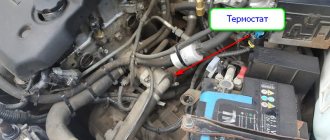The design and features of the cooling system on Grants (and they exist, and they are significant) are given in the post. The text was written not by an unknown Internet author, but by the plant itself. Overall, it's worth reading. But if you're lazy, I'll tell you the main thing. — The system has become much simpler, but it has not become worse. — The small circle always works and never overlaps — The thermostat has been simplified to the limit. Now there is only one valve - the large circle valve. — An enemy imported thermostat of non-traditional sexual orientation was used
Actually, what am I talking about? My thermostat is broken here. Well, how it broke. Strangely it broke. Not in one moment, not in one day, and not even in one month. Distinct signs appeared only in the fourth year of the car’s life. The opening temperature, previously clearly recorded by the BC, began to smooth out and spread out. If at first it grew vigorously up to 83°C, and then dropped sharply by several degrees (depending on the cold outside), then last winter it began to grow not very vigorously, and after 75-76°C - not at all vigorously . And after opening it moved down somehow blurredly. Slowly she moved down. While I was thinking about the mysterious behavior of the capricious thermostat, which did not fit into any framework of its possible malfunctions, winter was over. The problem has disappeared.
And at the beginning of October I went on vacation to sunny Abkhazia. As you know, the way there lies through the no less sunny Krasnodar Territory. And it so happened that I was in front of Dzhubga early in the morning. The weather was beautiful, and it was +6°C outside. And so, going down to Dzhubga, the BC showed the engine temperature 80...78...72...69...65...63. Dear Mom, the thermostat seriously died - it dawned on me. Something similar was repeated in the Tuapse-Sochi intestines. A clear upper limit - no hint of overheating when driving uphill. And a perfect temperature bottom when driving in engine braking mode from a mountain. Obviously, the thermostat allows fluid to flow into a large circle. Why? Is the valve stuck? Excluded. No overheating when driving uphill. Has the opening temperature mysteriously shifted down? This is against the laws of physics. The valve does not reach the seat, but works fine? Maybe, maybe an autopsy will show...
Upon returning to a completely non-sunny Moscow Region (as we know, the sun is covered by clouds in October and opens in April), at near-zero temperatures, even ten kilometers of driving along the highway was only enough to reach 76-78°C. It became clear that if you do not change the thermostat immediately, you will have to do it in the winter, in the cold. And this is fraught with a runny nose and sore throat.
Buying a thermoelement turned out to be not an easy task. The native one does not exist for sale at all. Luzar, according to the wishes of the workers, released a non-original, but it had to be ordered, and I no longer wanted to delay the replacement. And then I just bought the original thermostat assembly for 1100 rubles. And he did the right thing, by the way. I remind you. Neither the Priorovsky thermostat nor the Priorovsky thermoelement are suitable for us.
I changed it (I’ll tell you how to do this with minimal losses in the second episode) and everything, of course, returned to its original normal. Those. 83°C. Warm.
And here I stand with the thermostat removed in my hands and look at it like a ram at a new gate. The valve is tightly closed. I water it with hot tap water. The valve is closed. I pour boiling water on it - the valve opens vigorously and wide, and when it cools down it completely sits in place. Some kind of miracle. So I would have been playing with boiling water for a long time. And it’s possible that I would have scalded the egg at the end if it weren’t for the thought of blowing into the thermostat. It blew easily! And the poured water flowed out easily.
At this point many will say - author, you are stupid. I had to blow right away. But understand me too. I can clearly see with both eyes that the valve is seated tightly in the seat. It’s not easy to lift it even with a screwdriver - the spring is so strong. Then I halved the thermostat, put the valve in the seat and shined a flashlight on the back side. It glowed along the entire contact plane. And everything became clear.
The saddle is very worn. The valve was also worn out.
This is wear from strong contact stresses. This happens in bearings. It's called pitting. To put it simply, unevenly torn pieces of metal. Pitting in the thermostat? This is some kind of new word in automotive technology, you say. Nothing new. The usual shitty engineering. I don’t know, the plant itself wrote down a resource limitation in the technical specifications for the Korean fascists from Behr. Or they don’t know any other way. I will not lie. But this thermostat is doomed from birth. Structurally doomed. Take a closer look at the width of the saddle. It is less than 1 millimeter. Taking into account the gap between the working diameter of the valve and the well into which it enters, the overlap of the seat by the valve does not exceed half a millimeter on each side. Taking into account the horsepower of the spring, we get the horsepower pressure of the valve on the seat, and we get wear. Immediately after the warranty expires. And in order to sweep aside accidents and cover the ass of Korean scammers, VAZ writes an information letter in which it expands the boundaries of consciousness beyond the edge of the universe - 85+/-8.3°C. Where +8.3 is so that the fawn is not so noticeable, for camouflage. There won't be any plus eight and a half there. There is nowhere for them to come from. But minus eight and a half will definitely be there - just after the warranty expires. When the valve chews itself and the seat.
But we are not fools either. We'll cut the stem and restore the seat. There will be a spare thermostat))
Any car has an engine cooling system, which must maintain the operating temperature of the engine. The main element responsible for the stable temperature of the coolant is the thermostat; it regulates when to pass coolant through the cooling radiator and when to bypass it.
When this element fails, the car engine begins to operate in incorrect temperature conditions, which can lead to its breakdown.
In this article we will talk about the thermostat on a Lada Granta car, signs of its malfunction, methods of checking and replacing it yourself.
What is a thermostat for?
The Granta cooling system has two cooling circles: small and large. The small circle is designed to warm up the engine faster by circulating coolant past the radiator in a small circle. As soon as the car reaches operating temperature, the thermostat opens the path of coolant in a large circle to maintain operating temperature.
The operating temperature of the Lada Granta is 85°C.
The thermostat constantly works to open and close; when the temperature reaches above 85°C, it opens and the pump begins to circulate liquid in a large circle, and so on thousands of times over its entire service life.
Lada 2112 › Logbook › Improving the subsidy thermostat
To begin with, a year ago I received a thermostat under a BEHR grant. I searched for a thermostat from this particular company in my hometown for a long time and finally found it. After installing it, the car began to heat up faster and the heater began to heat up a little better, which is what I really wanted. Having driven with it for the winter, I noticed that with it the car keeps a driving temperature of 77-79, which is very low for the smooth operation of our engine. In the heat of the summer, even in the longest traffic jams, the car did not warm up willingly, which definitely pleased me, but in the end I decided to replace the 92-degree thermocouple. The Wahler 3091.92D thermocouple fits the BEHR housing without modification. The search for this item in my city was unsuccessful... Either the price was higher than the price of a complete thermostat, or the waiting time was more than a month. If I'm not mistaken, I was one of the first to implement the BUBLS-64 concession thermostat, how? and why?))) I also saw an improvement idea from him for people like me who couldn't find a Wahler fuser that would fit without any special modifications. This is a Wahler 3017.92D50 thermocouple. Again, it was nowhere to be found and I was offered a Wahler 3017.92D2 instead. They differ only in the presence or absence of a gasket. To implement it, it is necessary to grind a new plate, because the original one is less than 1 mm and, as a result, does not completely cover the circle and does not maintain a normal temperature. This item was purchased for 550 rubles and given to my dad to make a plate. I’ll say right away that the photos are not mine, because... I did it a month ago and didn’t even think about recording it on a record, so I didn’t take any pictures)) Here is a link to his black and white modification Grant 2190 or even a warmer thermostat.
BEHR Thermostat Assembly
Thermocouple and its plate
After the modification, the stove began to fry, and the consumption decreased by about 1.5 liters. With the help of this element, the moving temperature is maintained at 88-90 degrees. If anyone is interested in what and how, please ask questions)
To cool the power plant in every car today, specialized coolants are used, which make it possible to additionally organize heating of the car interior during the cold season.
Reliable operation of this system is ensured by special devices - thermostats. Their main function is to create conditions for rapid warming up of the engine and maintaining it in the required operating conditions.
Signs of a bad thermostat
A thermostat malfunction is most often discovered when cold weather sets in. One of the main signs will be a long time for the engine to warm up to operating temperature and a rapid drop in temperature when driving along the highway.
In hot weather, the thermostat can jam and constantly circulate fluid in a small circle, which will lead to boiling of the fluid and overheating of the engine, and this is an expensive repair.
- Long warm-up time in cold weather;
- Temperature drop when driving on the highway;
- The stove blows cold air;
- The car overheats and boils;
How to check the thermostat
The thermostat can be checked in two ways, but one of the checking methods is quite labor-intensive and is most often abandoned.
First way
To check, the thermostat must be removed. It is also necessary to prepare the tools and materials that will be used for the work.
What you need:
- Kitchen stove or burner;
- Thermometer;
- Container with water;
We immerse the dismantled thermostat in a container of water and boil it on the stove to a temperature of 85°C (a thermometer placed in the water will help determine the temperature). When the temperature reaches 85°C, the thermostat should open completely, but if it opens much earlier, it means it is faulty and must be replaced with a new one.
Second way
To check this method, there is no need to dismantle the thermostat, but the check must be carried out on a cooled engine. We start the engine and warm it up to operating temperature. At the moment when the engine has warmed up to 70°C, you need to touch the large circle pipe (this is the lower radiator hose), it should be cold. If the hose already warms up to 70°C, then it is necessary to change the thermostat, as it is faulty.
Carrying out an inspection
The process of controlling the thermostat is a relatively simple procedure. To begin, the removed thermostat cylinder is lowered into a transparent container into which the coolant has previously been poured. Subsequently, this container is heated, periodically stirring the coolant and monitoring with a thermometer the moment when the cylinder rod begins to move. When the coolant reaches a temperature of 85 C (± 2 C), the rod of a fully operational device will begin to extend. When the liquid in the container reaches 100°C (±2°C), it will come out completely.
Replacement
You can replace the thermostat either at a car service station or with your own hands, which will save you several hundred or even thousands of rubles.
To independently replace the thermostat on Grant, you need to prepare tools and materials.
Would need:
- Coolant capacity of 5 or 10 liters;
- Container for draining coolant;
- Thermostat;
- A set of keys;
- Sealant;
- Gasket for thermostat;
Let's get started
Remove the air filter housing and corrugation;
Drain the coolant by unscrewing the plug on the cylinder head block;
Loosen the clamps and remove the pipes suitable for the thermostat;
Remove the thermostat by unscrewing the 2 nuts securing it to the cylinder head;
We install the new thermostat in the reverse order and be sure to replace the gasket under the thermostat with a new one.
general information
There are single-valve, two-stage and two-valve thermostats, as well as electronically controlled devices. Grants are equipped with thermostats Luzar LT0191 and Luzar LT0190 (costing from 450 rubles for the first, and from 800 rubles for the second), FENOX TS034E7 (costing from 800 rubles), VAZ-2123 (article 2123-1306010, cost from 650 rub.). It is worth mentioning such devices as VAZ-2101 GATES (article TH14580, cost - from 350 rubles), VAZ-2121 GATES (article TH15380, approximate cost - from 500 rubles), VAZ-2110 (article 21082-1306010, cost - from 600 rub.) and other devices. They are located between the engine and the radiator, but it should be noted that there are differences in the location of the thermostats on Grants with eight-valve and sixteen-valve engines.
Their main task is to prevent the movement of antifreeze through the radiator until the car engine warms up to the required temperatures. Accordingly, if the car engine does not warm up, then the coolant does not move in a large circle. Usually the thermostat is activated when the engine reaches a temperature of 80-95C. Among other things, the thermostat helps reduce the amount of harmful emissions released into the atmosphere and minimize engine wear.
The thermoelement located inside the device is made of brass, has a cylindrical shape and is filled with artificial wax. When the engine reaches a temperature of approximately 82C, this substance begins to melt, which causes it to expand. This sets the valve in motion, it opens, after which the antifreeze begins to circulate through the car’s radiator. Turning off the motor causes the wax to solidify inside the thermostat and close the damper.
Below we will talk in more detail about possible malfunctions of thermostats, provide instructions for replacing and checking them, and also share a technique for reworking and upgrading this part, allowing you to increase its response threshold to 92C.
What is a thermostat and what is it for?
The thermostat (TC) is an automatic device that regulates the temperature of the coolant. The main purpose of the device is to promote rapid heating of the engine and at the same time prevent it from overheating. The coolant (coolant) first circulates through a small ring (ICE jacket - pump) until its temperature reaches 89–92 °C. Then the vehicle opens the valve, directing the coolant flow into the large ring of the cooling system (radiator - heat exchanger - expansion tank).
While the engine is running, the thermostat valve is in constant motion, reducing or increasing the flow of coolant into the second large circuit, depending on the intensity of engine operation and the air temperature outside the car.
Owner reviews
| № | Positive |
| 1. | Vladimir: I’ve been actively using the car for two years now, and there are no comments about the heating system. I know about the problem of premature valve opening, but for me it is not significant. |
| 2. | Kirill: after 45,000 km I noticed that the regulator opens the valve already at 81°C. I visited a service station, after diagnostics the technician said that the defect was known, but had not yet been corrected by the manufacturer. Comrades recommended shortening the stock rod. |
| 3. | Vitaly: after buying the car, I shortened the regulator rod by 2.0 mm, and the valve activation threshold increased to 87°. This is enough for me, I don’t need to increase it any more. |
| 4. | Dmitry: I knew about the problem of underheating even before buying the car, I prepared in advance. Instead of the standard core, I installed 3091.92 V at 90° C. Now the system works properly. |
| 5. | Gennady: at 80,000 km I replaced the flow regulator for the first time, did not install the original core, bought a Wahler: 3017.87 D. I have been actively using it for two months, no comments. |
| 6. | Alexander: a year has passed since the purchase of the car, the valve opens at 80°C. I know that the threshold is low, but it doesn’t matter to me. I did not notice any increased fuel consumption. |
| 7. | Vasily: after purchasing the car, I replaced the antifreeze with imported one, installed a core from Wahler: 3017.87 D. |
| Negative | |
| 1. | Ivan: The car is a year and a half old, but I can’t fix the problem of early activation of the valve. On the advice of my comrades, I changed the cores, sharpened the stem, nothing helps. |
| 2. | Alexey: extremely dissatisfied with the car, the model is crude, there are many flaws and defects. You constantly need to dig around and fix breakdowns. |
| 3. | Vasily: the thermostat was replaced after a mileage of 50,000 km, after which faults were discovered in the ignition system and so on. |
Conclusion
The problem of early activation of the thermostat valve on the Lada Grant (2190) is known. Engineers are constantly looking for a solution. As alternative, effective methods, use the tips outlined at the beginning of the article.
Do not forget that the operating temperature of the engine also depends on the brand of antifreeze (antifreeze), its properties and characteristics, and the type of engine oil.
Often the cause of poor heating is other failures associated with the functioning of the cooling system of the equipment.
Design and principle of operation
On Grants, both with 8 and 16 valve engines, Luzar LT0191 and LT190 thermostats are installed. Their fundamental structure is no different from similar devices on other cars. The vehicle on Grant is a cast brass cylinder with a lid and a side outlet pipe. Its main part is a thermoelement.
It is a copper cylinder filled with special wax (ceresin). As the temperature rises, the wax expands, pushing the stem outward, which in turn rests on the valve seat. When the temperature reaches above 92 °C, the rod fully opens the valve, freeing the passage of coolant into the large circuit through the radiator.
As the coolant heat decreases, the wax in the cylinder will shrink. The return spring will be activated, which will return the rod to its original position and the valve will close.
Sequencing
- We place the car within the perimeter of the repair area.
- Loosen the clamp of the air supply pipe (Phillips screwdriver).
- Remove the mass air flow sensor (MAF).
- We unscrew the expansion tank cap and remove the vacuum.
- We unscrew the three clamps on the cooling system distributor and pour the waste into a plastic container (about 3 liters).
Preparatory processes before installation
- We press the block with wires from the engine control unit, disconnect the temperature sensor terminal.
- Using a key set to “13”, unscrew the negative terminal and remove it from the regulator body.
- Using the “8” head, we loosen the clamps of the supply pipe – the antifreeze return to the radiator.
Supply pipe clamps
- Remove the rubber pipes from the regulator.
Disconnect the rubber pipes
- Using the “13” socket, unscrew the two nuts that secure the thermostat to the wall of the cylinder block.
Two nuts - clamps to the block
- We remove the mechanism from its normal place and clamp it in a vice for preventive maintenance.
Clamp in a vice
- Using a Torx T-30 wrench, unscrew the three screws of the cover and remove it.
Removing the cover
- The connection between the cover and the body is sealed with a rubber gasket. We inspect it, if there is mechanical damage or deformation, we replace it with a new one.
- We grab the spring with pliers, press it, and release the metal plate.
Metal plate
- Release the regulator bottle.
Regulator bottle
- To check the functionality of the distributor, lower it into a container of water, gradually heat it up, bring it to a temperature of 85 - 90°C. We observe the movement of the rod. In good condition, it will move closer to the top.
Temperature adjustment
- We assemble the parts in the reverse order and install them in their original place.
Note to the driver!
Installation location of the Grant thermostat
The location of the vehicle may be slightly different in Grant cars with 8 and 16 valve engines. The device is located on the side of the cylinder block. It is attached with its seat to the outlet hole of the engine jacket through a gasket. The device is secured with three nuts on studs installed in the body of the motor housing.
How to check Grant's thermostat
There may come a time when the vehicle stops functioning normally and phenomena such as:
- a significant increase in the warm-up time of the internal combustion engine;
- rapid boiling of the coolant after reaching a temperature of 92 °C;
- excessive fuel consumption;
- The engine does not warm up to the required temperature in winter.
In this situation, you need to know how to check the thermostat. This can be done in three ways.
- Tactile method
- Visual control
- Laboratory test
Tactile method
The engine is warmed up until the sensor readings on the instrument panel reach the desired value. Raise the hood and feel the lower radiator outlet pipe with your hand. If the device is working properly, the hose will be hot. However, the method does not provide a complete picture of the performance of the vehicle.
Visual control
The device is removed from the car and placed in a container, suspended in water. The movement of the valve will be visually visible. When the water boils, the seat will lower, revealing the hole. During cooling, the valve will, on the contrary, rise and close the passage.
Laboratory test
The thermostat is also placed in an aqueous environment, but rested on a solid base. A tripod with a dial indicator is connected to the vessel with water, the rod of which will rest rigidly on the upper valve of the vehicle. When the water is heated, the indicator readings are recorded. But this method is quite difficult to implement in a garage, so Lada Granta drivers rarely use it.
Tips for repairing a temperature control device are often published on the Internet. But this should not be done due to the fact that the device cannot be fully restored. It is best to buy and install a new thermostat on Grant.
Revision option
As evidenced by reviews from grant owners, the manufacturer supplies this model with a rather weak thermostat. Usually it opens access to antifreeze after the engine warms up to 80 radii. This is due to low-quality wax inserts, which we described above.
In most cases, such a problem is not perceived as something serious, since it does not harm the operation of the engine in any way. The only drawback is that in winter, when there is frost, the interior can be cool. The situation becomes more complicated if the owner of the car switches to gas.
In this case, it makes sense to modify the thermostat so that it opens at 92 degrees. To do this you will need to purchase a new one. The entire element does not need to be replaced, so only the insert is taken out of the purchased one.
Experts advise choosing the model – VERNET TH4898.92D. Its cost is low - approximately 400 rubles.
The step-by-step replacement procedure is as follows:
- first of all, the car is driven onto a ramp or pit;
- drain antifreeze from the cooling system;
- remove the air duct because it is in the way;
- the thermostat itself is dismantled (but you can leave it in place and only remove the cover from it, the main thing is not to lose the seal);
- the old thermocouple is removed and a new one is inserted;
- they press it with the original spring and limiter.
On average, the response temperature after such a procedure increases by 15 percent.
The whole process is recorded in this video:
All cars whose engines are cooled by a special liquid have at their disposal a device called a thermostat. Lada Granta is no exception.
In the Grant model, the thermostat is located between the radiator and the engine. In the article we will talk about the concept of a car thermostat, what components it consists of and how it functions, and also consider the main types of thermostat malfunctions.
The thermostat is called the antifreeze (antifreeze) temperature regulator in the engine cooling system. It increases the engine warm-up rate and maintains the required thermal state.
The key job of the thermostat is to hold back the flow of radiator fluid until the engine has warmed up. If the engine remains cold, the coolant does not pass through it to the radiator.
The thermostat opens when the engine temperature reaches 95 degrees. Thanks to its operation, the engine warms up faster. Thus, in the Lada Granta, the thermostat reduces the amount of harmful emissions and reduces engine wear to a minimum.
If desired, you can clearly see the operation of the thermostat at home. Place the thermostat in a container filled with water, then place it on the electric stove. As the moment of boiling water approaches, the thermostat valve will open approximately 2 cm. It is recommended to experiment with a new thermostat without removing yours from your own car.
Replacing the Grant thermostat
Over time, the device may exhaust its service life, and the valve will not operate correctly. The coolant will not be able to circulate in a large circuit and pass through the radiator. The liquid, remaining in the engine jacket, will quickly heat up and boil. In another case, the valve freezes in the open position, and the liquid constantly flows through a large circuit. The engine will take a long time to warm up. At the same time, fuel consumption will increase sharply. This is especially noticeable in cold weather. The car will need urgent thermostat replacement.
Step-by-step instructions for replacing the thermostat on a Lada Granta
Before starting work, you need to prepare a tool: a TORX T30 wrench, a 13mm socket and a Phillips screwdriver. After this, proceed as follows.
- The car is placed on a level area with the engine cooled down. Raise the hood cover.
- Remove the plug from the expansion tank.
- Remove the plug from the bottom of the radiator and drain the coolant into a clean container. The plug is screwed back in.
- Disconnect the connector with wires from the coolant temperature sensor.
- Use a Phillips screwdriver to loosen the hose clamps.
- The hoses are removed from the thermostat pipes.
- Unscrew the nut securing the wire shorted to ground on the upper stud of the vehicle body.
- Remove the nuts and washers from the remaining two studs.
- The thermostat is pulled off the studs.
- Remove the old gasket from the engine seat and install a new gasket.
- To ensure a good fit, the gasket can be lubricated with engine oil or a thin layer of sealant applied to it on both sides.
- The new thermostat is installed in the seat by threading the pins through the holes in the beads of the vehicle body.
- Put on the washers and the tip of the ground wire.
- The nuts are tightened with a wrench on studs.
- The vehicle pipes are lubricated with engine oil.
- Put on the hoses and secure them with clamps.
- Having unscrewed the top radiator cap, fill in coolant until the level in the expansion tank is between o and “max”. The plug is screwed back in.
- Start the engine and check that there are no coolant leaks in all connections of the cooling system.
- Once the operating temperature is reached, screw in the expansion tank cap. Previously, this is not done so that air pockets leave the system.
Lada Kalina Sedan STOCK › Logbook › Thermostat from Grants to Kalina. Part 2: introduction of a thermostat
I didn’t buy the Grantov lower pipe, because, firstly, they are only sold as a set, and secondly, I would have to buy a collective farm pipe from the expansion tank, or buy a Grantov pump intake pipe, but, again, this pipe will not outlet for return heating of remote control. Therefore, I decided to simply make an additional connection to the radiator return line - the pump intake pipe. I bought a pipe from 2110 in the shape of the letter “Zu”. For the role of a connector, I didn’t look for anything in stores, fortunately my second job has a lathe. Although it is on its last legs, something is rattling in the box, but such small work can be carried out without any problems.
Well, Day X has come. In order not to spill a single gram of precious liquid called antifreeze, we pump out this liquid using a pump through the remote control pipes. I will not describe this scheme in detail, I will only say that I came to this method myself after we drained a friend’s antifreeze in this way on his first focus. As they say, not a drop is missed!
When I saw the color and consistency of my antifreeze, I was a little upset. Besides the brake fluid, this is the only fluid that I haven't changed. Out of anger, I completely leaked everything. So, let's move on. To make it easier to dismantle the thermostat housing, remove the cylinder head.
I would like to note one important point. New studs for the thermostat housing must be taken for the Lada camshaft bed. They are 80 mm long. Don’t believe those who write that you need to take at least 90mm! In this case, you will have to put a bunch of washers. I already put 2 washers under the top pin, because... the end of the thread was visible. And one more nuance. The bottom pin needs to be screwed onto the sealant, because... it is through and goes straight into the water jacket.
Well, then we collect everything. I installed my own thermocouple, although it is slightly different from Grant’s. I did not file/cut the block for the single-terminal sensor, because... everything connects freely. I don’t know, maybe other people have something different, but that’s how it is for me. The upper radiator pipe was cut off by 5 centimeters to avoid bending. There was a small problem with the bottom one. My ten-piece pipe turned out to be longer in the place between the bends, so I took only a section of beech G from it. I cut 6-7 centimeters from the Kalinovsky pipe and, bending it slightly, connected everything. It was already about 10 o’clock, I was doing it at work, so there was no point or opportunity to run for another pipe. With this connection, the tensile pipe broke a little. I got out of this situation by putting a gas reducer diaphragm spring on it, which fit just perfectly.
What is it and how does it work
As you understand, the thermostat is a component of the cooling system of a car engine.
In short, the task of this element is to open and close the path for the movement of fluid that flows through a small or large circle.
The operation of the device is based on a physical phenomenon. Namely, on the expansion of the liquid when it is heated. The thermostat has a rather simple device, although in fact it is a sensor and an actuator in one bottle. It consists of a cylinder which is filled with a waxy liquid, powdered copper, aluminum and graphite. There is also a rod located inside the cylinder and a pair of spring-loaded valves. One valve is for the main (large) one, and the second is for the small circle of circulation of the cooling liquid.
During operation, this element is constantly exposed to the liquid that washes it. Heat is transferred to the contents of the cylinder.
When heating occurs, the wax in the cylinder expands, the rod is squeezed out along with the valve, marking the small circle. Thus, the small circulation circle is blocked, and the liquid begins to pass through the engine radiator, and not just through the stove radiator.
Features of the LADA Granta cooling system
As in previous LADA models, upon reaching a certain temperature, the thermostat switches the coolant flow from a small to a large circuit. The small circuit includes:
- cylinder water jacket;
- water pump;
- interior heater.
The difference is that the heater radiator is connected to a small circuit in series and not in parallel. This forces all the coolant to pass through it, improving the heating of the cabin. The thermostat opening temperature is 85 degrees. Upon reaching this mark, the valve opens and the liquid begins to circulate through a large circuit into which. In addition to the small circuit elements, a cooling radiator is included. The advantage of the modernized cooling system is that antifreeze from the engine jacket falls directly onto the thermostat thermocouple without mixing in its housing. This allows the element to respond to the actual engine temperature, opening on time and preventing overheating. The manufacturer has set the permissible thermostat opening range to 85–7 degrees. That is, it can open at both 78 and 93 degrees. According to the official letter from the manufacturer, sent to dealers, the operating temperature of the Grant engine may be 10 degrees lower than that of previous VAZ models. This does not mean that the engine is “underheated” and does not lead to an increase in fuel consumption, deterioration of lubrication and a decrease in engine life. However, owners of the LADA Grant often change the thermostat to a new one, with an opening temperature closer to 90 degrees, or modify the standard thermostat by changing the thermal element.
Where is it located
There are many options for what will happen if the thermostat is constantly open on a large or small circle. This will lead to overheating, antifreeze may be released from the expansion tank, the normal pressure in the cooling system will change, and more.
This unit cannot be allowed to malfunction. It is used on all machines:
- on Kalina;
- on Priora;
- VAZ 2114;
- VAZ Classic;
- Ford Focus;
- VAZ 2110;
- Chevrolet Aveo;
- Gazelle Next;
- VAZ 2107;
- Lada Granta;
- Renault Logan, etc.
To check the serviceability of this element on a car, as well as to detect signs of a dying thermostat, you need to at least roughly understand where it is located.
I can't say it's difficult to do.
It is objectively correct to immediately look at the instruction manual. In the section where the cooling system is described, the location of the required element must be indicated.
At the same time, there is a fairly universal search method that is relevant for almost all domestic cars and many foreign cars.
To find a thermostat you need to do the following:
- open the hood;
- find the thickest pipe;
- this will be the radiator hose;
- it goes from the radiator to the engine;
- the second end of this pipe is connected to the thermostat;
- get to the second end;
- determine the location of the thermostat housing;
- start removing it.
Although I still advise you to first look at the manual, and only then start searching, dismantling and repair work.
Signs of trouble
From what was said earlier, we can conclude that the thermostat is responsible for opening the small and large circle of circulation of the cooling liquid, which is ready-made antifreeze or antifreeze concentrate diluted with your own hands.
When starting a cold internal combustion engine, a small circle operates, which helps to warm up the engine and the interior heater faster. Having reached a certain temperature, the sensor is triggered and the system switches to a large circle, transferring engine heat to the internal combustion engine radiator. This prevents the motor from overheating. If the system jams and circulates fluid in a small circle, the engine will inevitably overheat and a number of other ensuing consequences will occur. That is, such situations cannot be allowed to arise.
If the thermostat fails, two main situations may occur.
In the first case, the thermostat switches the cooling system so that a large circulation circle is closed. As a result, the engine gets hot and the gauges on the dashboard go off scale. The motor may jam and related systems and components may fail.
The second situation is somewhat different. Here the thermostat is already stuck in the open position.
In this position, the coolant will constantly flow through a large circuit, affecting the radiator. If it is warm outside, this will not cause any significant problems for the car or the driver himself. So this is less of a reason to panic. But in winter, you will quickly notice that the thermostat is faulty. In cold weather, a power unit with a faulty coolant sensor will slowly warm up, fuel consumption will increase, the heater will not function properly, and the cabin will feel cold.
If you notice that the engine is overheating, or the interior is cold and the heater is not working, this largely indicates problems with an element such as the thermostat.










